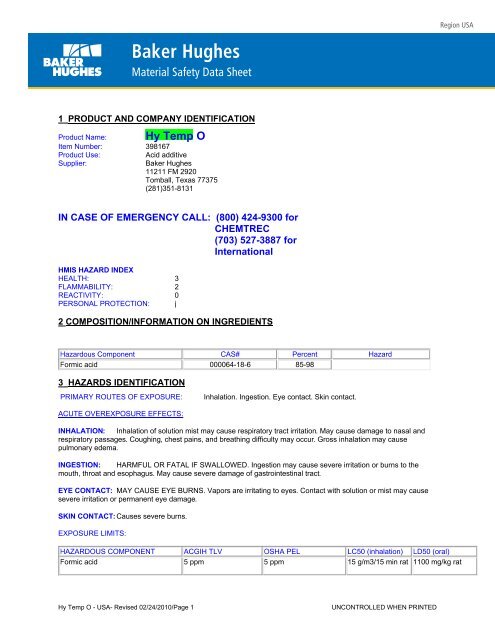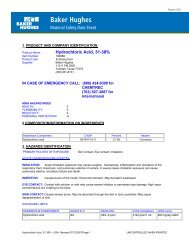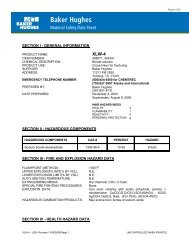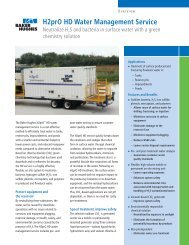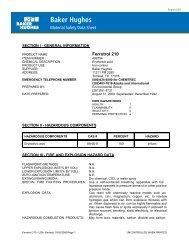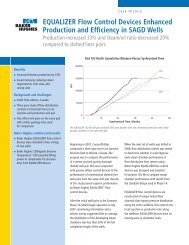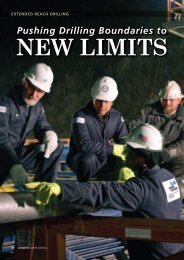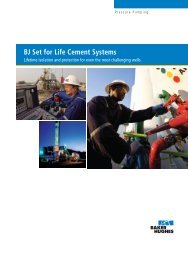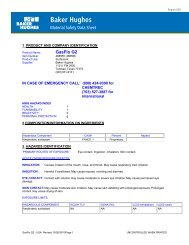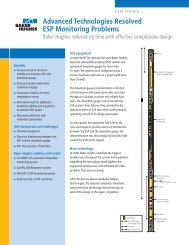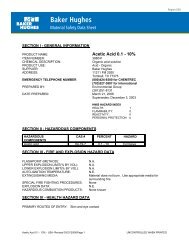Hy Temp O - USA- Revised 02/24/ - Baker Hughes
Hy Temp O - USA- Revised 02/24/ - Baker Hughes
Hy Temp O - USA- Revised 02/24/ - Baker Hughes
Create successful ePaper yourself
Turn your PDF publications into a flip-book with our unique Google optimized e-Paper software.
Region <strong>USA</strong><strong>Baker</strong> <strong>Hughes</strong>Material Safety Data Sheet1 PRODUCT AND COMPANY IDENTIFICATION<strong>Hy</strong> <strong>Temp</strong> OProduct Name:Item Number: 398167Product Use:Acid additiveSupplier:<strong>Baker</strong> <strong>Hughes</strong>11211 FM 2920Tomball, Texas 77375(281)351-8131IN CASE OF EMERGENCY CALL: (800) 4<strong>24</strong>-9300 forCHEMTREC(703) 527-3887 forInternationalHMIS HAZARD INDEXHEALTH: 3FLAMMABILITY: 2REACTIVITY: 0PERSONAL PROTECTION: j2 COMPOSITION/INFORMATION ON INGREDIENTSHazardous Component CAS# Percent HazardFormic acid 000064-18-6 85-983 HAZARDS IDENTIFICATIONPRIMARY ROUTES OF EXPOSURE:Inhalation. Ingestion. Eye contact. Skin contact.ACUTE OVEREXPOSURE EFFECTS:INHALATION: Inhalation of solution mist may cause respiratory tract irritation. May cause damage to nasal andrespiratory passages. Coughing, chest pains, and breathing difficulty may occur. Gross inhalation may causepulmonary edema.INGESTION: HARMFUL OR FATAL IF SWALLOWED. Ingestion may cause severe irritation or burns to themouth, throat and esophagus. May cause severe damage of gastrointestinal tract.EYE CONTACT: MAY CAUSE EYE BURNS. Vapors are irritating to eyes. Contact with solution or mist may causesevere irritation or permanent eye damage.SKIN CONTACT: Causes severe burns.EXPOSURE LIMITS:HAZARDOUS COMPONENT ACGIH TLV OSHA PEL LC50 (inhalation) LD50 (oral)Formic acid 5 ppm 5 ppm 15 g/m3/15 min rat 1100 mg/kg rat<strong>Hy</strong> <strong>Temp</strong> O - <strong>USA</strong>- <strong>Revised</strong> <strong>02</strong>/<strong>24</strong>/2010/Page 1UNCONTROLLED WHEN PRINTED
4 FIRST AID MEASURESINHALATION:If inhaled, remove to fresh air. If not breathing give artificial respiration, preferably mouth-to-mouth. If breathing isdifficult give oxygen. Only trained personnel should administer oxygen. Get medical attention.INGESTION:Rinse mouth with water several times. DO NOT induce vomiting. Give victim plenty of water. Obtain medicalassistance immediately.EYES:In case of contact, or suspected contact, immediately flush eyes with plenty of water for at least 15 minutes and getmedical attention immediately.SKIN:Rush to the nearest hose or shower where the skin should be flushed with large amounts of water for at least 15minutes while removing contaminated clothing. Get immediate medical attention.5 FIRE FIGHTING MEASURESFLASHPOINT (METHOD):118-154°FLOWER EXPLOSION LIMIT (% v/v): 18UPPER EXPLOSION LIMIT (% v/v): 57SPECIAL HAZARDS:May form flammable vapour-air mixture. This product or a component there of can flow along surfaces to reach adistant ignition source and flash back.EXTINGUISHING MEDIA:Water fog, carbon dioxide, foam, dry chemical.SPECIAL FIREFIGHTING PROCEDURES:Fire-fighters should wear self-contained breathing apparatus and full protective clothing when fighting chemical fires.Cool exposed containers with water spray.HAZARDOUS COMBUSTION PRODUCTS:Oxides of carbon.6 ACCIDENTAL RELEASE MEASURESWear specified protective equipment. Remove sources of ignition. Small spills - Cover spill with absorbent material.Scoop absorbed material into a suitable container for disposal. Large spills - Dike to contain. Prevent from enteringsewers or waterways. Recover product to suitable containers or vessel for reuse, if possible, or for disposal.(Neutralization should be performed only under controlled conditions by specially trained personnel.) Use onlyexplosion proof transfer equipment.7 HANDLING AND STORAGEHANDLING:Use only in a well ventilated area. Wear specified protective equipment. Use only spark-proof and explosion-prooftools and equipment.STORAGE REQUIREMENTS:Keep container tightly closed, in a cool, well ventilated place. Keep away from heat. Keep away from ignition sources.Keep away from incompatible materials.8 EXPOSURE CONTROLS/PERSONAL PROTECTIONSPECIFIC ENGINEERING CONTROLS:Use only in a well ventilated area. Local exhaust.PERSONAL PROTECTIVE EQUIPMENT:Cartridge respirator. Chemical resistant goggles. Face shield. Butyl rubber gloves. Neoprene gloves. (Resistance tobreakthrough > 480 min) Rubber boots. Rubber apron. Coveralls.9 PHYSICAL AND CHEMICAL PROPERTIES<strong>Hy</strong> <strong>Temp</strong> O - <strong>USA</strong>- <strong>Revised</strong> <strong>02</strong>/<strong>24</strong>/2010/Page 2UNCONTROLLED WHEN PRINTED
PHYSICAL STATE:LiquidCOLOR:Colorless/pale yellowODOR:PungentODOR THRESHOLD:Not available/applicableSPECIFIC GRAVITY:1.2 @ 68 FVAPOR PRESSURE: 4.67 kPa @ 20°CVAPOR DENSITY (air = 1): 1.6EVAPORATION RATE: 2 (n-butyl acetate = 1)BOILING POINT: 101 - 105°CFREEZING POINT:-13°C (85% sol.); +8°C (98% sol.)pH:2.2 (1% sol.)SOLUBILITY IN WATER: Complete10 STABILITY AND REACTIVITYSTABILITY:Stable under normal conditions of use.INCOMPATIBILITY/CONDITIONS OF REACTIVITY:May react violently with strong acids (nitric, sulphuric), bases or oxidizers. Aluminum. Corrosive to steel.HAZARDOUS THERMAL DECOMPOSITION PRODUCTS:Carbon monoxide. Carbon dioxide.HAZARDOUS POLYMERIZATION:Will not occur.11 TOXICOLOGICAL PROPERTIESCHRONIC EFFECTS:Respiratory ailments. Pulmonary edema. Liver and kidney damage.SENSITIZATION:Not known.CARCINOGENICITY:None of the components of this product have been listed as carcinogenic by IARC, NTP or OSHA. (IARC-International Agency for Research on Cancer) (NTP - National Toxicology Program) (OSHA - Occupational Safety &Health Administration (US))MUTAGENICITY:Not known.REPRODUCTIVE TOXICITY:Not known.12 ECOLOGICAL INFORMATIONNo specific information available.13 DISPOSAL CONSIDERATIONSWASTE DISPOSAL:Disposal should be made in accordance with national and local regulations. Consult local waste authorities fordirection and/or approvals prior to disposal.14 TRANSPORT INFORMATIONLAND TRANSPORT (DOT)Proper Shipping Name: FORMIC ACIDUN/ID No.: UN 1779Hazard Class - Primary: 8Hazard Class - Secondary: 3Packing Group:II<strong>Hy</strong> <strong>Temp</strong> O - <strong>USA</strong>- <strong>Revised</strong> <strong>02</strong>/<strong>24</strong>/2010/Page 3UNCONTROLLED WHEN PRINTED
Reportable Quantity (RQ):Emergency Response Guide #:AIR TRANSPORT (ICAO/IATA)Proper Shipping Name: FORMIC ACIDUN/ID No.: UN 1779Hazard Class - Primary: 8Hazard Class - Secondary: 3Packing Group:IIMARINE TRANSPORT (IMDG/IMO)Proper Shipping Name: FORMIC ACIDUN No.: UN 1779Hazard Class - Primary: 8Hazard Class - Secondary: 3Packing Group:IIEmS:F-E, S-C15 REGULATORY INFORMATIONSARA TITLE III:SECTION 3<strong>02</strong>/304Hazardous Substance.SECTION 311/312SECTION 313Chemicals.This product does not contain substances listed in Appendix A and B as an ExtremelyFire, ImmediateThis product does not contain ingredients (at a level of 1% or greater) on the List of ToxicTSCA INVENTORY: The substances in this product are included on or exempted from the TSCA 8(b) Inventory(40 CFR 710).CALIFORNIA PROP 65: This product does not contain substances which requirewarning under California Proposition 65.PRIORITY POLLUTANTS: None16 OTHER INFORMATIONISSUE DATE: <strong>02</strong>/<strong>24</strong>/2010PREPARED BY: <strong>Baker</strong> <strong>Hughes</strong>REFERENCES:Supplier's Literature.CCINFO Web Information Service, Canadian Centre for Occupational Health and Safety, 2007.Dangerous Goods Regulations, 48th ed., International Air Transport Association, 2007.Restructured ADR - European Agreement Concerning the International Carriage of Dangerous Goods by Road,United Nations, New York and Geneva, 2001. Vols. I, II.International Marine Dangerous Goods Code, 20<strong>02</strong> Edition , International Maritime Organisation, 20<strong>02</strong>.TDG Clear Language Regulations, as published in the Canada Gazette Part II, August 2001.Guide to Occupational Exposure Values - 2007, American Conference of Governmental Industrial <strong>Hy</strong>gienists, 2007.EH40/2005 Workplace exposure limits, Health and Safety Executive, Norwich, 2005.The information contained herein is based on data considered accurate. However, no warranty is expressed orimplied regarding the accuracy of these data or the results to be obtained from the use thereof. Vendor assumesno responsibility for injury to vendee or third persons proximately caused by the material if reasonable safetyprocedures are not adhered to as stipulated in the data sheet. Additionally, vendor assumes no responsibility forinjury to vendee or third persons proximately caused by abnormal use of the material even if reasonable safetyprocedures are followed. Furthermore, vendee assumes the risk in his use of the material.<strong>Hy</strong> <strong>Temp</strong> O - <strong>USA</strong>- <strong>Revised</strong> <strong>02</strong>/<strong>24</strong>/2010/Page 4UNCONTROLLED WHEN PRINTED
<strong>Hy</strong> <strong>Temp</strong> O - <strong>USA</strong>- <strong>Revised</strong> <strong>02</strong>/<strong>24</strong>/2010/Page 5UNCONTROLLED WHEN PRINTED


